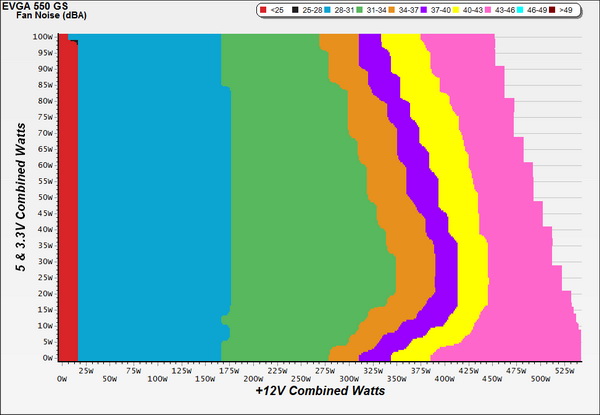EVGA SuperNOVA 550 GS PSU Review
EVGA teamed up with Seasonic to release an affordable, mid-capacity, 80 PLUS Gold, fully modular PSU, the SuperNOVA 550 GS, which costs just $90.
Why you can trust Tom's Hardware
Efficiency, Temperature And Noise
Efficiency
Our efficiency testing procedure is detailed here.
Using the results from the previous page, we plotted a chart showing the 550 GS' efficiency at low loads, and loads from 10 to 110 percent of the PSU's maximum-rated capacity.
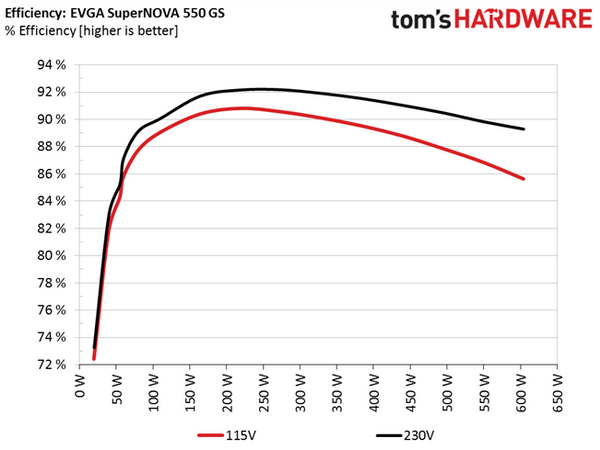
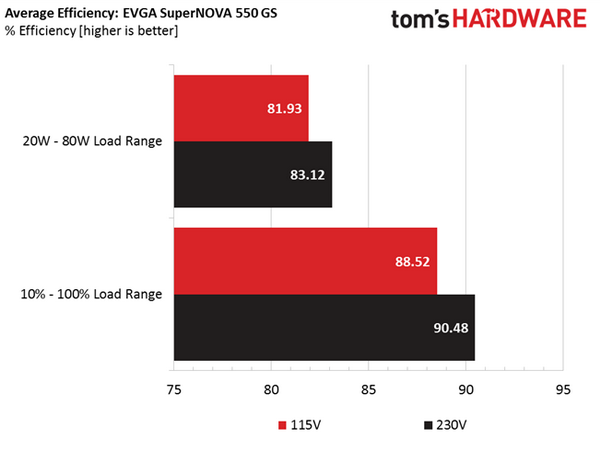
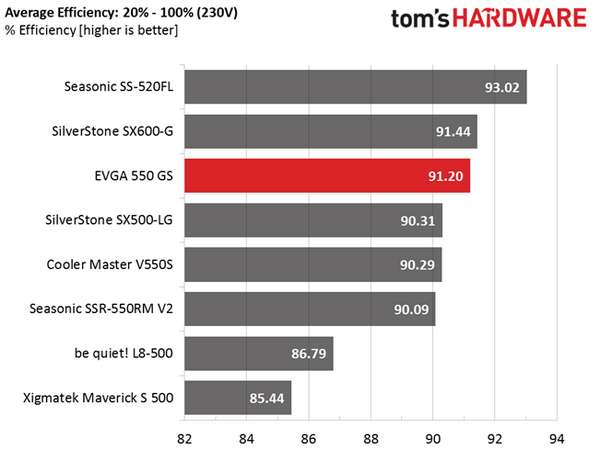
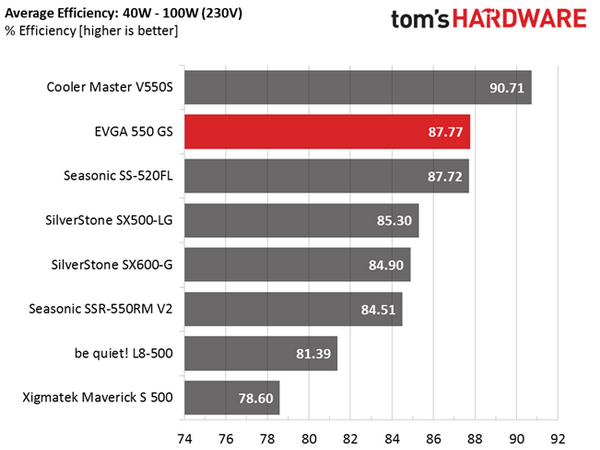
Under both light and normal loads, the 550 GS enables high efficiency levels, which in both cases surpass the performance of Seasonic's G-550 V2, a supply that competes with EVGA's offering.
Efficiency At Low Loads
In the following tests, we measure the efficiency of the 550 GS at loads significantly lower than 10 percent of the device's maximum capacity (the lowest load the 80 PLUS standard measures). The loads we dialed were 20, 40, 60 and 80W. This is important for representing when a PC is idle, with power-saving features turned on.
| Test | 12V | 5V | 3.3V | 5VSB | Power DC/AC | Efficiency | Fan Speed | Fan Noise | PF/AC Volts |
|---|---|---|---|---|---|---|---|---|---|
| 1 | 1.193A | 0.491A | 0.475A | 0.195A | 19.69W | 72.39% | 600 RPM | 27.3 dB(A) | 0.892 |
| 12.237V | 5.092V | 3.367V | 5.093V | 27.20W | 114.9V | ||||
| 2 | 2.410A | 0.979A | 0.98A | 0.389A | 39.73W | 81.80% | 600 RPM | 27.3 dB(A) | 0.953 |
| 12.231V | 5.088V | 3.361V | 5.085V | 48.57W | 115.0V | ||||
| 3 | 3.633A | 1.466A | 1.488A | 0.590A | 59.85W | 85.79% | 600 RPM | 27.3 dB(A) | 0.978 |
| 12.223V | 5.084V | 3.355V | 5.075V | 69.76W | 115.0V | ||||
| 4 | 4.845A | 1.963A | 1.970A | 0.785A | 79.73W | 87.72% | 600 RPM | 27.3 dB(A) | 0.986 |
| 12.215V | 5.079V | 3.350V | 5.068V | 90.89W | 115.0V |
At light loads, the PSU offers high efficiency levels along with low noise output. In three out of the four light-load tests, efficiency easily passed the 80 percent mark. And with 80W load, we measured close to 88 percent efficiency, which is impressive.
5VSB Efficiency
The ATX specification states that 5VSB standby supply efficiency should be as high as possible, recommending 50 percent or higher efficiency with 100mA of load, 60 percent or higher with 250mA of load and 70 percent or higher with 1A or more of load.
We will take four measurements: one each at 100, 250 and 1000mA, and one with the full load the 5VSB rail can handle.
Get Tom's Hardware's best news and in-depth reviews, straight to your inbox.
| Test | 5VSB | Power DC/AC | Efficiency | PF/AC (V) |
|---|---|---|---|---|
| 1 | 0.102A | 0.52W | 67.53% | 0.118 |
| 5.104V | 0.77W | 115.4V | ||
| 2 | 0.252A | 1.28W | 71.91% | 0.227 |
| 5.099V | 1.78W | 115.4V | ||
| 3 | 1.002A | 5.09W | 80.03% | 0.376 |
| 5.080V | 6.36W | 114.9V | ||
| 4 | 2.502A | 12.62W | 78.24% | 0.443 |
| 5.043V | 16.13W | 114.9V |
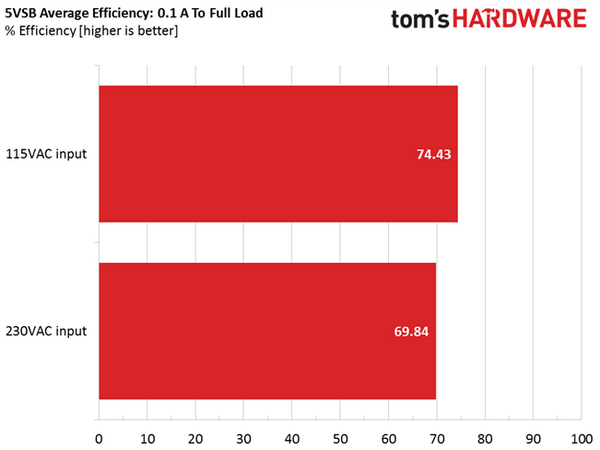
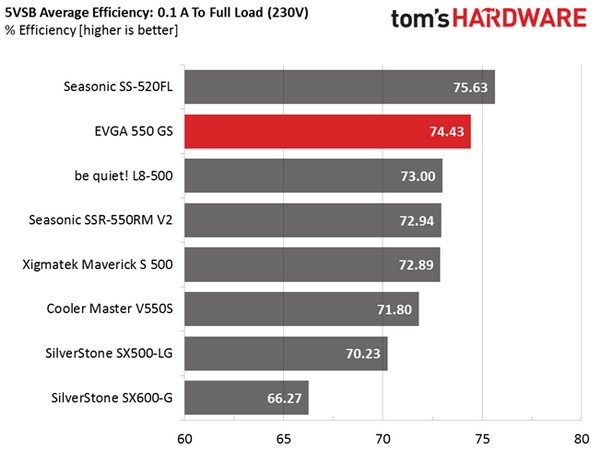
The 5VSB rail proves to be highly efficient, losing only to the high-end Seasonic fanless unit, which utilizes a higher-grade platform.
Power Consumption In Idle And Standby
| Mode | 12V | 5V | 3.3V | 5VSB | Power AC | PF/AC (V) |
|---|---|---|---|---|---|---|
| Idle | 12.241V | 5.100V | 3.377V | 5.106V | 6.54W | 0.549 |
| 115.2V | ||||||
| Standby | 0.11W | 0.019 | ||||
| 115.4V |
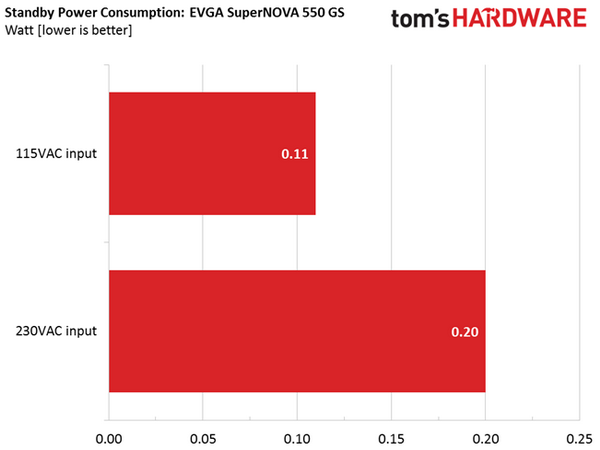
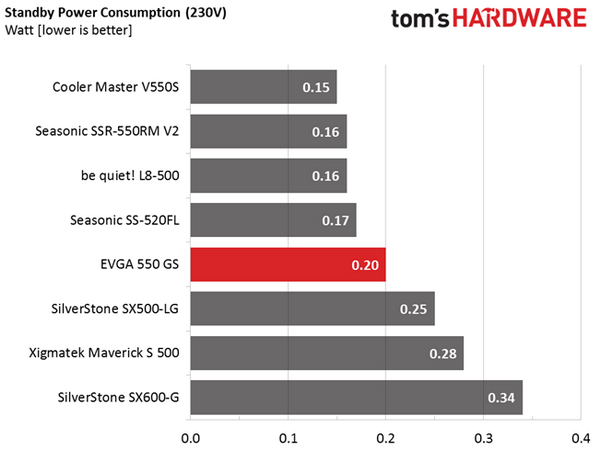
In the table above, you'll find the power consumption and voltage values of all rails (except -12V) when the PSU is idle (powered on, but without any load on its rails), and the power consumption when the PSU is in standby mode (without any load, at 5VSB).
In all cases, energy consumption at standby was very low, easily meeting the ErP Lot 6 2013 requirements. At the same time, this helped achieve high efficiency levels on the 5VSB rail.
Fan RPM, Delta Temperature And Output Noise
Our mixed noise testing is described in detail here.
The first chart below illustrates the cooling fan's speed (RPMs), and the delta between input and output temperature. The results were obtained at 36 degrees C to 45 degrees C ambient temperature.
The next chart shows the cooling fan's speed (RPMs) and output noise. We measured acoustics from one meter away, inside a small, custom-made anechoic chamber with internals completely covered in sound-proofing material (be quiet! Noise Absorber kit). Background noise inside the anechoic chamber was below 18 dB(A) during testing, and the results were obtained with the PSU operating at 36 degrees C to 45 degrees C ambient temperature.
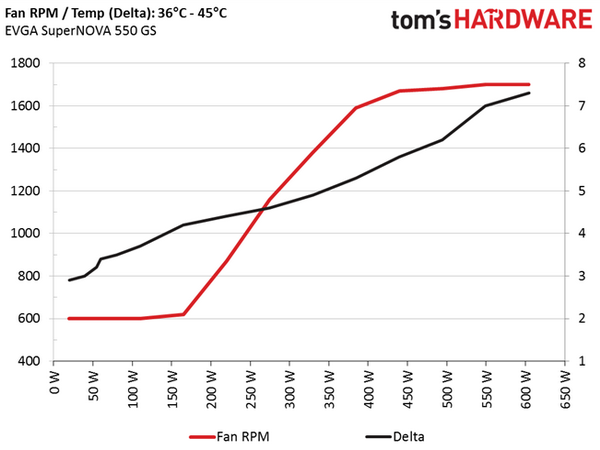
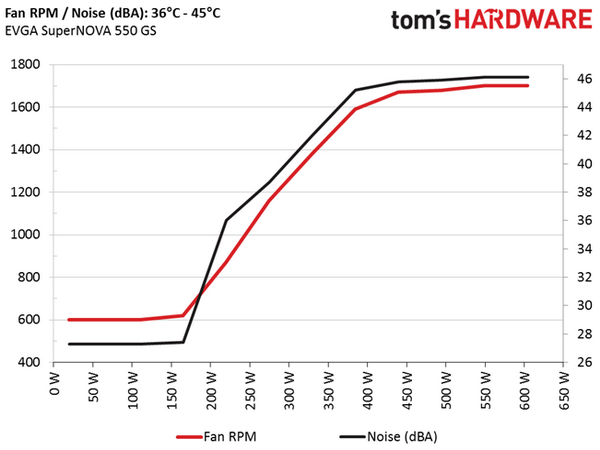
The following graph illustrates the fan's output noise over the entire operating range of the PSU. The same conditions of the above graph apply to our measurements, though the ambient temperature was between 28 degrees C and 30 degrees C.
As you can see from the graph above, the passive mode doesn't last long; however, the PSU's noise output was low enough up to around 200W to 250W. Above that, the noise output increased, entering the loud region with 350W and higher loads.
Current page: Efficiency, Temperature And Noise
Prev Page Load Regulation, Hold-Up Time And Inrush Current Next Page Cross-Load Tests And Infrared Images
Aris Mpitziopoulos is a contributing editor at Tom's Hardware, covering PSUs.
-
Aris_Mp my last reviews were of smaller capacity units and I will try to bring even more of them.Reply -
Luay Coorection, EVGA did release a gold rated 1050W and 850W Seasonic PSU also branded as GS, and a platinum 1000W PS. There's also a 650W version of the PSU reviewed here which takes the total to five Seasonic OEMs branded by EVGA.Reply -
Larry Litmanen ReplyThere are less rippletastic options at that price point.
For the most part when it comes to PC parts you get what you pay for. Unless you spot a great sale, a 550W fully modular, 80 Gold PSU from a company like EVGA with a 5 year warranty. EVGA is super easy to deal with should you need to replace a unit. All that for $90? If this PSU was a 650W unit with same features and for the same price it would have been perfect.
-
atheus Reply
You mean the price would have been perfect? Confusing idea to change the wattage rather than just change the price. I take that to mean instead of a certain price/performance you would rather have a 650 watt PSU than a 550.There are less rippletastic options at that price point.
For the most part when it comes to PC parts you get what you pay for. Unless you spot a great sale, a 550W fully modular, 80 Gold PSU from a company like EVGA with a 5 year warranty. EVGA is super easy to deal with should you need to replace a unit. All that for $90? If this PSU was a 650W unit with same features and for the same price it would have been perfect.
I see 650 watt PSU's as only for SLI systems, which are fairly niche. With 550 you can handle any single GPU, and in the case of Maxwell GPU's <= 980 you could even SLI them so long as you aren't doing some obscene overclocking or running a dozen fans and pumps and a datacenter worth of HDD's. So for my go-to wattage for a standard high performance single GPU build is 550. For medium performance 450 is even better. -
logainofhades Unless you really feel the need for a gold rated PSU, I would probably save some cash and stick with a Seasonic 520w or 620w M12II. Even the 750w B2 series is cheaper.Reply -
Aris_Mp ReplyCoorection, EVGA did release a gold rated 1050W and 850W Seasonic PSU also branded as GS, and a platinum 1000W PS. There's also a 650W version of the PSU reviewed here which takes the total to five Seasonic OEMs branded by EVGA.
This is exactly what I write inside the review. Four GS PSUs and one PS.
"So far, the new PS series includes only a single unit with 1kW of max power; EVGA's GS line, on the other hand, has four PSUs with 550, 650, 850 and 1050W capacities."
I also have the 650 GS in my lab, but this isn't for Tom's.
